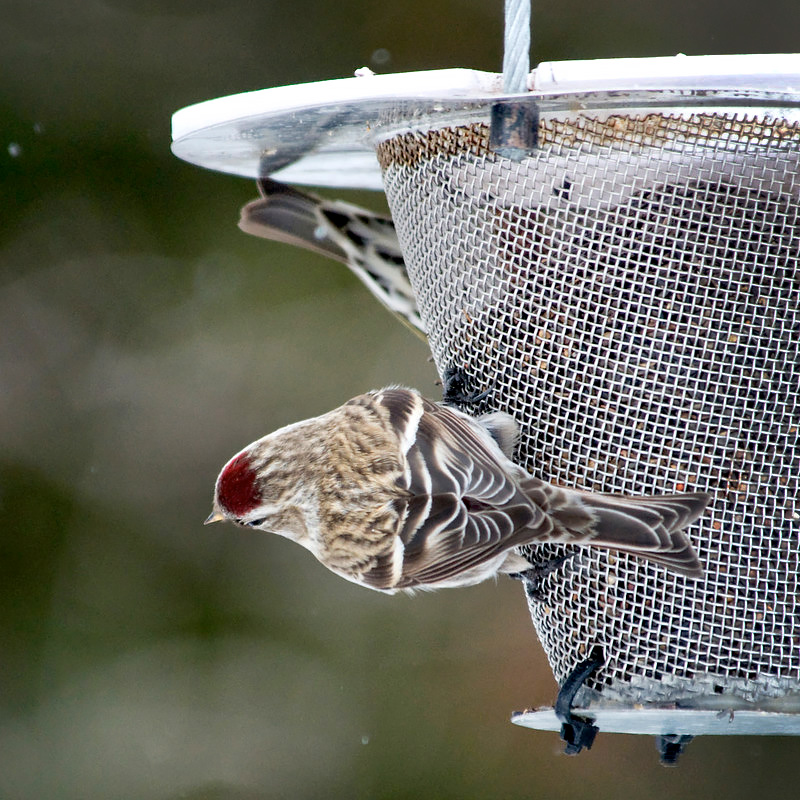House Finches Red Headed Sparrow Bird : Discover the Vibrant Beauty of Nature
by onleaves

The House Finch and Red-Headed Sparrow are both species of bird commonly found in North America. The House Finch (Haemorhous mexicanus) and Red-Headed Sparrow (Ammodramus maritimus) are two types of birds frequently found across North America.
These small birds are often seen in backyards, gardens, and open habitats, making them easily observable by birdwatchers and nature enthusiasts. House Finches are known for their vibrant red or orange heads, while Red-Headed Sparrows have distinct rusty-red caps. Despite looking similar in size and shape, they can be distinguished by their plumage patterns and specific behaviors.
Both species have adapted well to human-altered environments, and their presence adds color and liveliness to many landscapes throughout North America. Understanding the characteristics and behavior of these birds is essential for those interested in avian diversity and conservation efforts across the continent.

Credit: www.chicagobotanic.org
The Alluring Traits Of House Finches Red Headed Sparrow Bird
House Finches Red Headed Sparrow Bird is a visually stunning avian species that captivates bird enthusiasts with its diverse colors and patterns. The feathers of these birds exhibit an incredible range of hues, from vibrant oranges and reds to soft pinks, creating a mesmerizing spectacle in nature.
What sets House Finches Red Headed Sparrow Bird apart from other birds are its distinctive physical characteristics. Their striking red-headed appearance grabs attention instantly, making them easily recognizable. Moreover, these birds boast a unique blend of color patterns across their bodies that vary from individual to individual.
With their alluring features and vibrant plumage, House Finches Red Headed Sparrow Birds enhance the beauty of the natural world. Their presence in our surroundings adds a touch of elegance and charm to the avian kingdom, making them a fascinating sight for birdwatchers and nature enthusiasts alike.
The Habitat And Distribution Of House Finches Red Headed Sparrow Bird
House Finches Red Headed Sparrow Bird, scientifically known as Haemorhous mexicanus, is a species of finch that can be found across North America. These birds are known for their vibrant red plumage on the head of the males. The geographic distribution of House Finches Red Headed Sparrow Bird spans from southern Canada to Mexico, covering a wide range of habitats.
House Finches Red Headed Sparrow Bird have shown remarkable adaptability to different environments. They can thrive in urban areas, suburban neighborhoods, as well as rural landscapes. Their ability to adapt to various habitats has made them a common sight in gardens, parks, and even city centers. These birds are known to build nests in trees, shrubs, and even man-made structures like birdhouses.
Despite their adaptability, House Finches Red Headed Sparrow Bird do have geographic variations in the habitats they favor. In more arid regions, they can be found in desert areas, while in cooler climates, they tend to seek shelter in wooded areas. Their diet also varies depending on their location and available food sources, with a preference for seeds, fruits, and insects.
In conclusion, the House Finches Red Headed Sparrow Bird is a versatile species that can adapt to different environments and has a wide geographic distribution. Its vibrant appearance and adaptability make it a fascinating bird to observe in various habitats.
The Life Cycle And Behavior Of House Finches Red Headed Sparrow Bird
House Finches Red Headed Sparrow Birds are fascinating creatures known for their unique life cycle and behavior. These birds engage in elaborate mating rituals and courtship displays. The males showcase their vibrant red crown feathers and melodious songs to attract potential mates. Females carefully evaluate these displays before choosing a suitable partner.
When it comes to nesting, House Finches Red Headed Sparrow Birds prefer to build their nests in shrubs, trees, or even man-made structures like birdhouses. Their nests are constructed using twigs, grass, leaves, and other materials, providing a safe environment for their offspring.
Once the eggs are laid, both the male and female actively participate in incubation duties. They take turns keeping the eggs warm and protecting them from predators. This shared parenting behavior highlights the strong bond between the pair.
As the chicks hatch, parents tirelessly feed and care for their young, ensuring their survival. The chicks grow rapidly and soon fledge, leaving the nest to explore the world around them.
The life cycle and behavior of House Finches Red Headed Sparrow Birds is truly a spectacle worth appreciating. These remarkable creatures exemplify dedication, love, and resilience in the bird kingdom.
The Feeding Habits And Diet Of House Finches Red Headed Sparrow Bird
House Finches Red Headed Sparrow Bird’s preferred food sources and foraging techniquesHouse Finches Red Headed Sparrow Bird have distinct dietary preferences and foraging techniques that contribute to their health and survival. These birds primarily feed on seeds and fruits, particularly those found in plants such as sunflowers, dandelions, and coneflowers. They are also known to consume insects, like caterpillars and beetles, especially during breeding seasons to provide extra protein for their young. House Finches Red Headed Sparrow Bird exhibit a unique foraging behavior, usually found in small groups or pairs. They are ground-foragers and often sift through plants and shrubs to find desired food resources. These birds have a strong bill that allows them to access seeds from various sources, showcasing their adaptability in different environments. By utilizing their keen sight, they efficiently locate and gather food while flying in close proximity to their preferred habitats. Ensuring a balanced diet is crucial for the health and survival of House Finches Red Headed Sparrow Bird. Seed feeders, offering sunflower and thistle seeds, are a popular way to attract and provide them with nutritional resources. Supplying fruit-bearing plants in gardens or yards can also entice these birds and supplement their diet. Maintaining a diverse food supply plays a significant role in supporting the overall well-being and population of these beautiful birds. |
The Role Of House Finches Red Headed Sparrow Bird In Ecosystems
House Finches Red Headed Sparrow Birds play a crucial role in ecosystems, particularly in vegetation and plant pollination. These birds have a significant impact on the dispersal of seeds, as they consume large quantities of fruits and berries. As they move from one location to another, House Finches Red Headed Sparrow Birds inadvertently aid in the spread of seeds, contributing to the diversity and growth of plant populations.
Moreover, House Finches Red Headed Sparrow Birds also contribute to plant pollination. As they forage for nectar, they inadvertently transfer pollen from one flower to another, facilitating the fertilization process and ensuring the reproduction of various plant species. This process greatly benefits the overall health and sustainability of ecosystems.
In addition, House Finches Red Headed Sparrow Birds have ecological relationships and interactions with other species. They are often preyed upon by certain predators, such as hawks and snakes, which helps maintain the balance of predator-prey dynamics in the ecosystem.
| Ecological Relationships of House Finches Red Headed Sparrow Birds | |
|---|---|
| Predators | Hawks, Snakes |
| Prey | Fruits, Berries |
The Threats And Conservation Efforts For House Finches Red Headed Sparrow Bird
A table is an effective way to present the information about the threats and conservation efforts for the House Finches Red Headed Sparrow Bird. Below is a table summarizing the main points:
| Threats | Conservation Efforts |
|---|---|
| 1. Habitat loss due to urbanization and deforestation | 1. Establishment of protected areas and conservation reserves |
| 2. Predation by invasive species | 2. Control and management of invasive species populations |
| 3. Climate change and its impact on food availability | 3. Research and monitoring of climate change effects |
| 4. Pollution and pesticide use | 4. Promotion of sustainable agricultural practices |
| 5. Illegal trapping and trade | 5. Enforcement of laws and regulations against wildlife trafficking |
| 6. Collision with man-made structures like buildings and communication towers | 6. Implementation of bird-safe building guidelines |
These conservation measures and initiatives are essential for the protection and preservation of the House Finches Red Headed Sparrow Bird population. By addressing these threats and implementing proactive conservation strategies, we can ensure the long-term survival of this species.
Enjoying The Beauty Of House Finches Red Headed Sparrow Bird In Your Backyard
Observing and appreciating the vibrant beauty of House Finches Red Headed Sparrow Bird in your own space can be a rewarding experience. To attract these lovely creatures to your backyard, it’s important to create a bird-friendly environment.
Start by providing ample food sources such as bird feeders filled with a variety of seeds. House Finches Red Headed Sparrow Birds are particularly fond of sunflower seeds. Additionally, planting native plants and flowers will not only offer natural food sources but also provide shelter and nesting opportunities.
Water is also essential to attract birds. Consider installing a bird bath or a small pond where House Finches Red Headed Sparrow Birds can drink and bathe.
Avoid using pesticides and insecticides in your backyard as they can harm birds and their food sources. Instead, opt for natural alternatives or beneficial insects to maintain a healthy ecosystem.
By following these tips, you can create a welcoming environment for House Finches Red Headed Sparrow Birds and enjoy their beauty right in your own backyard.
Frequently Asked Questions On House Finches Red Headed Sparrow Bird
What Is The Difference Between A House Finch And A Red Headed Sparrow?
A House Finch has a red head and chest, while a red-headed sparrow has a red head only.
What Looks Like A Sparrow But Has A Red Head?
The bird that looks like a sparrow but has a red head is called a red-headed finch.
Is A House Finch A Sparrow?
No, a House Finch is not a sparrow. They belong to different bird families.
Is There A Difference Between A Sparrow And A Finch?
Yes, there is a difference between a sparrow and a finch in terms of their characteristics and appearance.
Conclusion
The House Finch and the Red Headed Sparrow are fascinating bird species that can bring joy and beauty to any backyard. These birds have distinct features and behaviors that make them stand out from other birds. The House Finch is known for its vibrant red head and breast, while the Red Headed Sparrow boasts a stunning red cap on its head.
Both species are known for their melodious songs and can add a soothing soundtrack to your outdoor space. By providing a suitable habitat and offering a variety of bird feeders and food, you can attract these birds to your yard and enjoy their presence year-round.
So, whether you are an avid bird watcher or simply appreciate nature’s wonders, consider welcoming House Finches and Red Headed Sparrows into your backyard for a delightful and harmonious experience.
The House Finch and Red-Headed Sparrow are both species of bird commonly found in North America. The House Finch (Haemorhous mexicanus) and Red-Headed Sparrow (Ammodramus maritimus) are two types of birds frequently found across North America. These small birds are often seen in backyards, gardens, and open habitats, making them easily observable by birdwatchers and…
Recent Posts
- Is Bhoothakaalam the Perfect Movie for Your Next OTT Binge-Watch Session?
- Financial Success with Nivesh Mitra: Your Trusted Investment Companion
- Manav Sampada Portal at ehrms.upsdc.gov.in for Viewing the E-Service Book
- School Insights Navigate Shala Darpan with Staff Login @ rajshaladarpan.nic.in
- Maharashtra Employment 2023: Register Online for Job Opportunities





